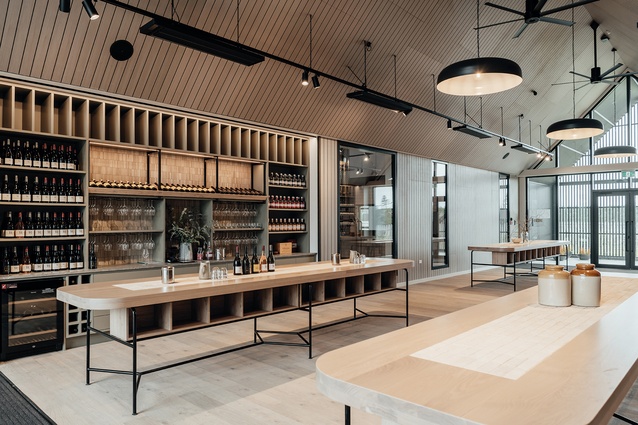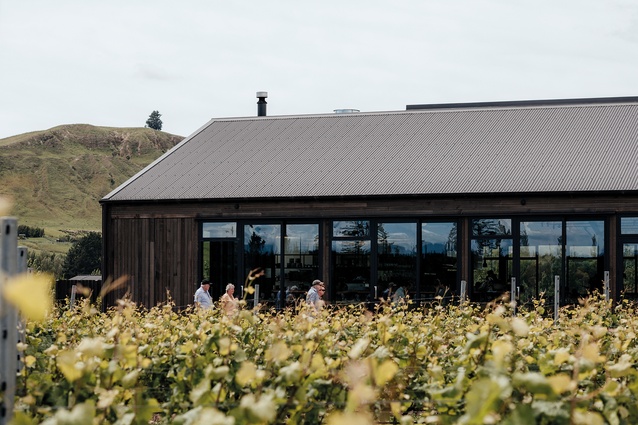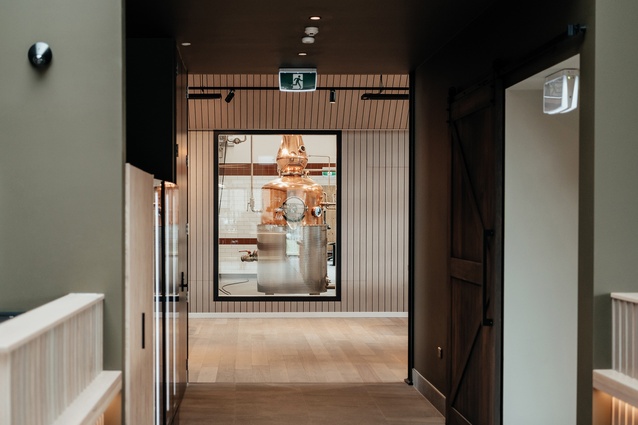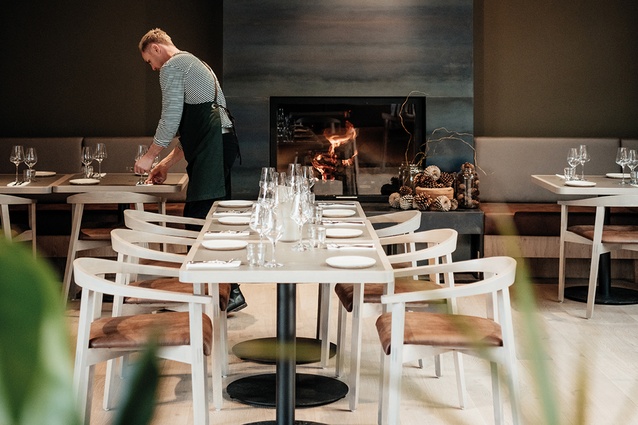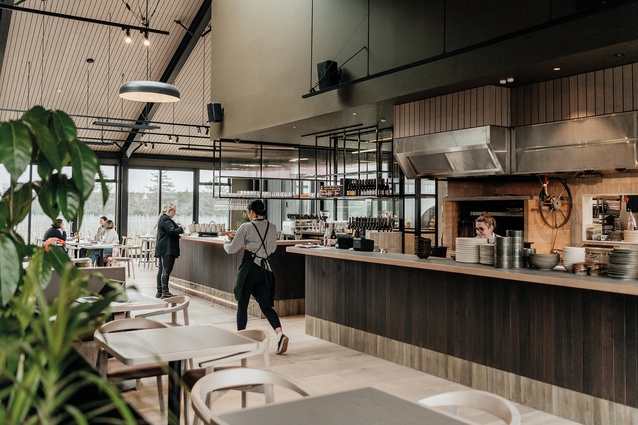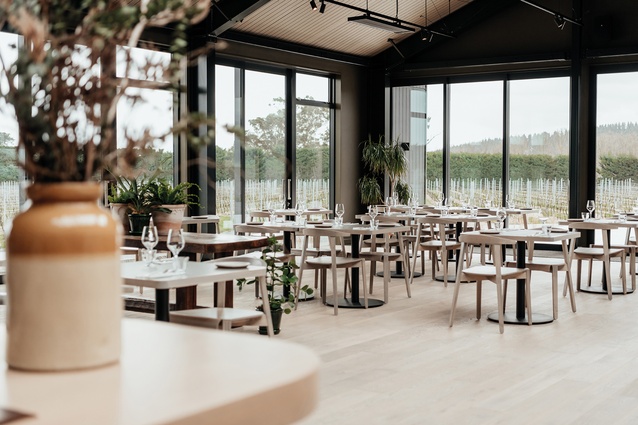Energy at the cellar door
It's interesting that, as an industry, we’re so caught up in the whole ‘shed’ vernacular. After all, we’re not the only country to lay claim to sheds. But working within this typology seems to appeal to our sense of modesty and humility, and perhaps there’s some comfort in the familiar.

The latest offering to join the Martinborough vineyard scene is most definitely an elegant, and somewhat elevated, shed. Here, Christchurch-based architect Charlie Nott has designed a woolshed, set amongst a scattering of casually dispersed rural buildings. It is a shed of such heft, it could rival a celebrated 1883 counterpart on the Maraekakaho Station, some 250km north in Hawke’s Bay.
Nott’s imposing timber and metal-clad structure is arrived at by way of a circuitous driveway, passing first a barrel-roofed shed decked out in street art by contemporary artist and dog enthusiast Andrew Steel, and then the original cellar door, a small, unassuming stockman’s cottage, previously relocated from the plains below.
The land, which is home to Te Kairanga vineyard, was once owned and farmed by runholder John Martin (after whom Martinborough is named), one of 11 orphaned Irish siblings who landed at Wellington’s Port Nicholson in 1841: hence the name for the new home to Foley Wines’ latest hospitality offering, The Runholder. Here, three brands are housed under the one roof – Te Kairanga, Martinborough Vineyard and Lighthouse Gin – and Nott, who’s first foray into the wine industry was with Escarpment’s Larry McKenna (the godfather of pinot) in 2001, was called on to design the new build.
In what seems to be typical Nott understated fashion, there is no grand arrival to The Runholder’s front door but rather to a parking area at the northeast, from which visitors pass first the service entrance to the kitchen and then an outdoor terrace at the side of the building. This low-key entry path provides a clever workaround to what might otherwise have been a procession of cars coming between the restaurant and its views to the vineyard.

The large front porch is partially screened by vertical timber slats, rising to the pitch of the sixmetre- high gabled roof and designed to diffuse some of the prevailing nor’wester, which, according to locals, “barrels through the region” during spring.
Once inside, a cathedral-like space opens ahead – generous in light and floor area, and warm in its welcome. It is flanked on either side by the cellar door’s offering but it is the view to the neighbouring hills that is the show-stopper. “We’re not only sitting within a working vineyard,” says Nott, “we’re also looking out onto the Wairarapa landscape.” Previously, only a small window in the lab of the adjacent winery enjoyed this view but now it is celebrated by all who enter the new building.
The interior is relaxed and unpretentious although clearly carefully detailed. Décortech timber veneer ceiling and wall panels convey a rural architectural language but, at the same time, do the heavy acoustic work. The space will need it, as three to four groups could potentially gather around the generous tasting tables at a given time, leading to heightened and enthusiastic discussion on the respective notes of the product being sampled.
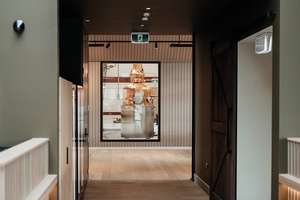
Sitting in all its magnificence behind a glazed wall in this central atrium is a shining work of art, a custom-built, 700-litre Carl copper-pot still from Germany. Lighthouse Gin’s previous still had a 200-litre capacity so the new arrival will enable head distiller Rachel Hall to scale up production for the international market. On the distillery’s walls, two bands of red tiles bookend a section of white subway tiles in reference to the gin’s Aaron Pollock-designed branding, inspired by the distinctive red stripes on the nearby Cape Palliser lighthouse.
There is energy in this cellar door and a genuine air of conviviality and hospitality. The wide circulation space makes for ease of movement and interaction, and the tiled and textured surfaces and open cabinetry create an almost domestic atmosphere, which is what Nott and interior designer Jessica Page were aiming for. “We wanted it to feel like your living or dining room,” says Page, “a building that everyone could relate to.”
At just shy of 1100m², The Runholder is large but the architects have cleverly carved out spaces for various functions. The cellar door defines the building’s axial centre, with two distinct zones created at either side, one for hospitality and the other for back-of-house, staff, storage and bottling. Below, sits the vineyard’s large 650m² barrel hall, home to more than 1300 barrels, a plant room and luncheon space.
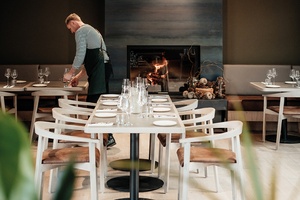
Set halfway between the ground floor and barrel hall is a walnut-toned VIP room, also overlooking the countryside to the east, offering a hushed respite from the wine-tasting above.
On moving through the cellar door to the dining area, a brief moment of spatial compression is bordered by premium wine storage and a hallway leading to the bathrooms. Then, the space releases, as it opens again to the lofty ceiling. Designed to house the magic large-function ‘pax loading’ of 120 to 150 guests, the floor area is generous and a variety of spaces has been created to break up the plan. More intimate dining beside an open, black-steel fireplace offers banquette seating and a small number of tables and, opposite, a large open-plan dining area looks out across the vines. The kitchen and bar take centre stage between the two, with all the kit a top chef could ask for, including a pizza oven, charcoal grill and smoker.

It’s in this space that the project’s relative newness is evident but its soul and personality will, no doubt, develop with the layering of art and ornament. The weather, too, is challenging the newcomer, with both the sun and the wind making their presence felt on the north-western façade. A run of opening vertical timber screens would go some way to mitigate this and, as the landscaping beds in, it will also diffuse some of the breeziness. The terrace area, which was designed largely with functions in mind, lends itself to a heavy, loggia-type structure with drop-down sides. Like good wine, these things take time to develop but, already, The Runholder is proving popular with the local community and visitors from out of town, for both its exceptional menu and its welcoming staff.
Nott judges the success of a project on how people use the building and how comfortable they feel. “I’m not a statement architect who does statement buildings,” he says. “I want to design buildings that people can enjoy and embrace, and this seems especially important in provincial areas.” He believes architecture in hospitality, and particularly in viticulture, should reflect and reinforce the brand and it appears this building is doing just that. It has seamlessly and adeptly woven together a story of the site’s lineage, reminding us of the past while extending the conversation into the future. Long live the shed.

